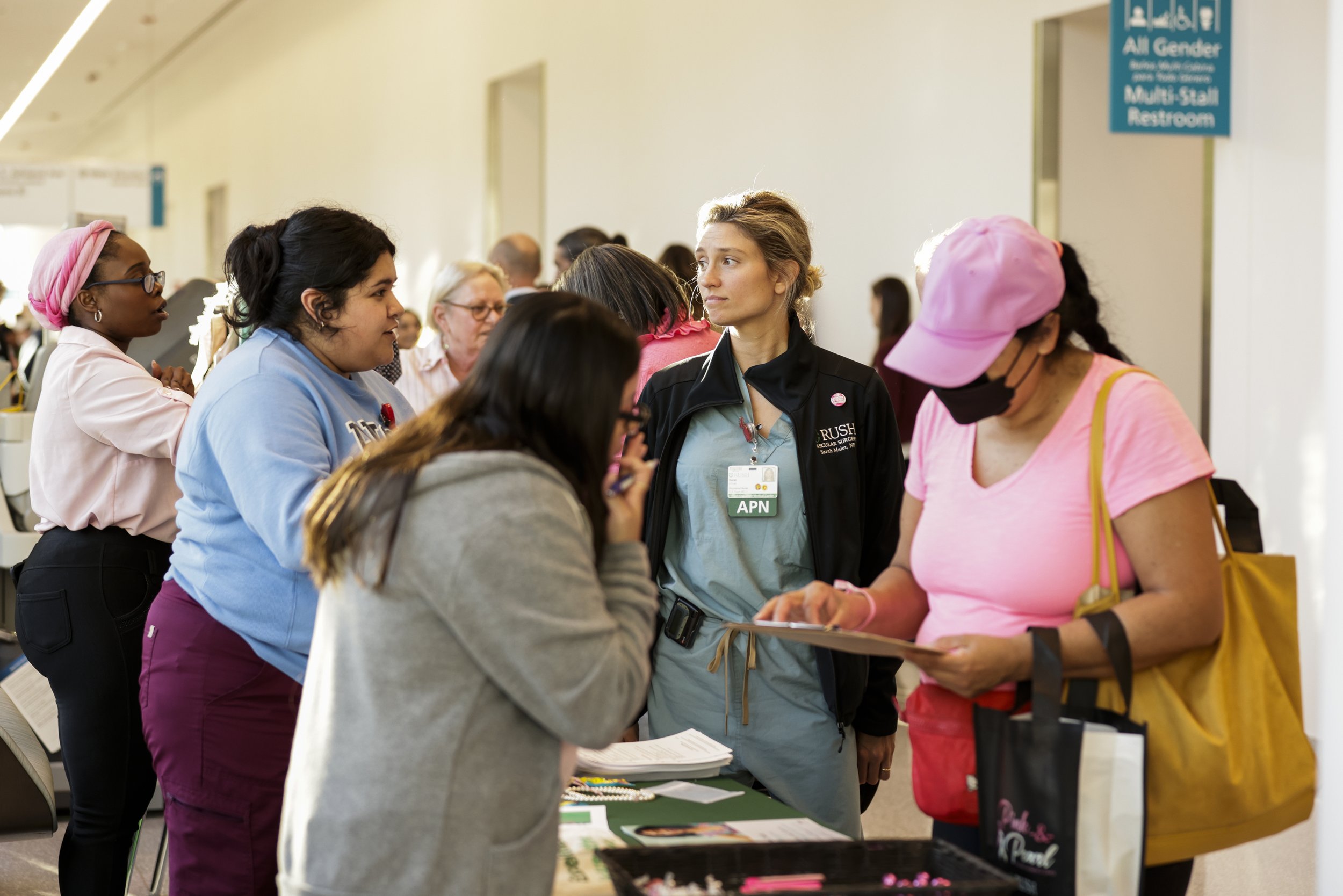Fluid Like Water: Community Health Workers in the RUSH Cancer Center
By Rae Anstett
The webinar series Social Determinants of Health Screening (SDOH): Navigating to Address Barriers, hosted by the American Cancer Society, highlighted how Community Health Workers (CHWs) conduct SDoH screenings effectively. Through these screenings, CHWs can identify and address barriers to equitable care.
The following focuses on two sessions from this series, both featuring the interdisciplinary and patient-specific work by CHWs in the RUSH Cancer Center.
Screening Tools, Workflow, Tracking, and Documentation
On January 9th, 2024, CHaSCI’s Managing Director Bonnie Ewald described CHWs’ work to document, utilize, and collect data around SDoH screenings. Ewald characterized how CHWs implement the current SDoH screenings and how future directions will develop. The full session can be viewed here.
Main takeaways from this session:
The 5 A’s of addressing barriers to care are raising awareness of needs, adjusting by need how care is implemented, providing assistance, aligning with community partners, and advocating to ensure access.
The interprofessional supportive oncology team consists of distress response social workers, social work care managers, patient navigators, and nurse navigators.
Main CHW roles:
Conduct initial SDoH screenings and follow up every 6 months.
SDoH domains include transportation, housing, food, utilities, employment, and interpersonal violence.
Provide social care interventions to patients who screen positive for 1 or more need.
Navigate patients through community health resources (texted, emailed, printed).
Build rapport through shared cultural and lived experience.
Identify caregivers and refer to RUSH's Caring for Caregivers program.
Coordinate food delivery with Rush’s Food is Medicine program—once/month delivery of produce and protein for 3 months.
Refer to health promotion and socialization programming through Rush Generations.
Escalate to supportive oncology SW care managers and other care team members.
CHWs document through electronic health record using SDoH screener, progress notes in narrative form, and a post encounter form (time spent, # of contacts, interventions, team data) with corresponding dashboards.
Data like screening rates, outcomes, and common needs guide further SDoH screening use, including how to fund resources (the most common needs being transportation and food insecurity) and built-in case support, vicarious trauma, grief and loss sessions.
Looking ahead, future directions include how patients experience the value of SDoH, the potential to expand workflow and partnerships, electronic health record revisions, and alignment with new Medicare Part B billing.
The 5 A’s of addressing barriers to care. Source: National Academies of Science, Engineering, and Medicine (NASEM). https://nap.nationalacademies.org/resource/25467/09252019Social_Care_key_messages.pdf
Taking It from Checking the Box to Meaningful Action
On January 23rd, 2024, the series continued with speakers from the RUSH Office of Community Health Equity and Engagement (CHEE), a department that frequently partners with CHaSCI for training and community health initiatives.
In this session, Lexi Artman (System Manager, Community Health Strategy and Programs, CHEE) and Ebony Henderson (Lead CHW-MA, CHEE) explained how CHWs act as bridges between clinic and community through the trust built in shared lived experiences. CHWs provide resources including connection to socialization programs, escalation to social workers, and reflective listening. According to Henderson, CHWs are “fluid like water,” meaning they adapt their care empathetically and patient-centrically depending on patients’ individual and complex needs. The full session can be viewed here.
Main takeaways from this session:
Workflow
SDoH screener is conducted via MyChart or iPad during check-in for new patients, who are then rescreened in-person or telephonically every 6 months.
Any positive needs lead to a referral to a CHW, who individualizes an ERx (electronic prescription for resources) within a 5-mile radius of the patient’s home.
Patient and Community Voice
To ensure alignment with needs, patients and community are part of the conversation about what is and is not working, how services need to change, and which resources should be maximized. CHWs encourage patient and community involvement through relationship-building & empathy, in addition to initiatives from the Rush Generations Community Engagement Council and annual/ongoing patient meetings.
For example: in one patient impact story, a patient screened positive for transportation as a need, so a CHW provided resources around PACE vouchers, 5 free rides, parking, paratransit, ACA's Road to Recovery, etc. The patient then identified an additional need for 2 sets of PACE vouchers: one for the patient, and one for the patient’s caregiver. It is now standard for a CHW to provide vouchers for both the patient & caregiver to support the whole patient.
CHW training fosters skills and competencies around chronic needs, insurance, mental health, engagement, navigation, and advocacy; administrative knowledge of electronic health records, social referral platforms, and ED & cancer center-specific departments; and “boots on the ground” shadowing.



